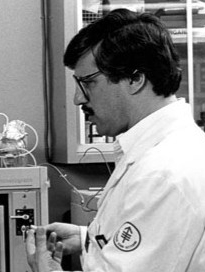Effects of recombinant human tumor necrosis factor α, recombinant human γ-interferon, and prostaglandin E on colony formation of human hematopoietic progenitor cells stimulated by natural human pluripotent colony-stimulating factor, pluripoietin α, and recombinant erythropoietin in serum-free cultures Journal Article
| Authors: | Lu, L.; Welte, K.; Gabrilove, J. L.; Hangoc, G.; Bruno, E.; Hoffman, R.; Broxmeyer, H. E. |
| Article Title: | Effects of recombinant human tumor necrosis factor α, recombinant human γ-interferon, and prostaglandin E on colony formation of human hematopoietic progenitor cells stimulated by natural human pluripotent colony-stimulating factor, pluripoietin α, and recombinant erythropoietin in serum-free cultures |
| Abstract: | The influences of pure human pluripotent colony-stimulating factor, highly purified pluripoietin a, pure recombinant human tumor necrosis factor a, pure recombinant human 7-interferon, and natural prostaglandin E 1 (PGE 1 ) were evaluated on colony formation of multipotential and erythroid progenitor cells in the presence of recombinant erythropoietin and hemin and on colony formation of granulocyte-macrophage progenitors in normal human marrow cultured in the presence or absence of serum. Serum was replaced by bovine serum albumin, iron-saturated transferrin, cholesterol, and calcium chloride. Increasing concentrations of pluripotent colony-stimulating factor and pluripoietin a stimulated increasing numbers of colonies from nonadherent low-density T-lymphocyte-depleted cells in the absence and presence of serum. Growth was usually greater in the presence of serum and on a unit basis pluripoietin a was more active than pluripotent colony-stimulating factor. Recombinant human tumor necrosis factor a and recombinant human 7-interferon suppressed colony formation colony forming unit-granulocyte-macrophage, burst forming unit-erythroid, and colony forming unit-granulocyteerythroid-macrophage-megakaryocyte; PGE 1 suppressed colony formation by colony-forming unit-granulocyte-macrophage, stimulated colony formation by burst forming unit-erythroid, and had no effects on colony formation by colony forming unit-granulocyte-erythroid-macrophage-megakaryocyte in both serum-containing and serum-free medium. The PGE 1 enhancing effects on erythroid colony formation required T-lymphocytes. Thus, results are similar using serum-containing and serum-free cultures of human bone marrow cells and serum-free defined culture medium can be used to study the mechanisms of action of purified natural and recombinant growth and suppressor molecules in vitro. © 1986, American Association for Cancer Research. All rights reserved. |
| Keywords: | unclassified drug; human cell; drug efficacy; bone marrow cells; erythropoietin; erythroid precursor cell; erythropoiesis; in vitro study; tumor necrosis factor-alpha; gamma interferon; recombinant gamma interferon; indometacin; recombinant proteins; hematopoietic stem cells; hematopoiesis; prostaglandin e; prostaglandins e; glycoproteins; prostaglandin e1; colony-stimulating factors; normal human; culture media; tumor necrosis factor; colony formation; interferon type ii; colony stimulating factor; humans; human; priority journal; article; lymphokines; blood and hemopoietic system; pluripoietin |
| Journal Title: | Cancer Research |
| Volume: | 46 |
| Issue: | 9 |
| ISSN: | 0008-5472 |
| Publisher: | American Association for Cancer Research |
| Date Published: | 1986-09-01 |
| Start Page: | 4357 |
| End Page: | 4361 |
| Language: | English |
| PUBMED: | 3089590 |
| PROVIDER: | scopus |
| DOI/URL: | |
| Notes: | Article -- Export Date: 18 August 2021 -- Source: Scopus; Acknowledgments: We wish to thank Stephanie Moore and Shirley Duke for excellent secretarial assistance. |
Citation Impact
Related MSK Work




